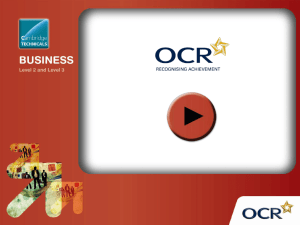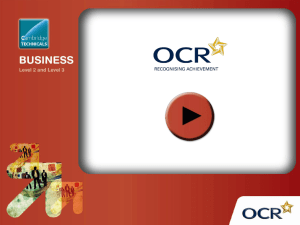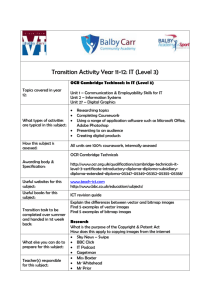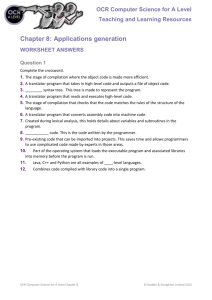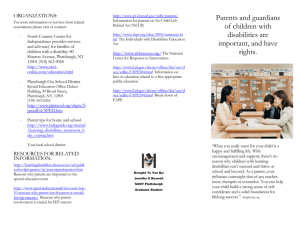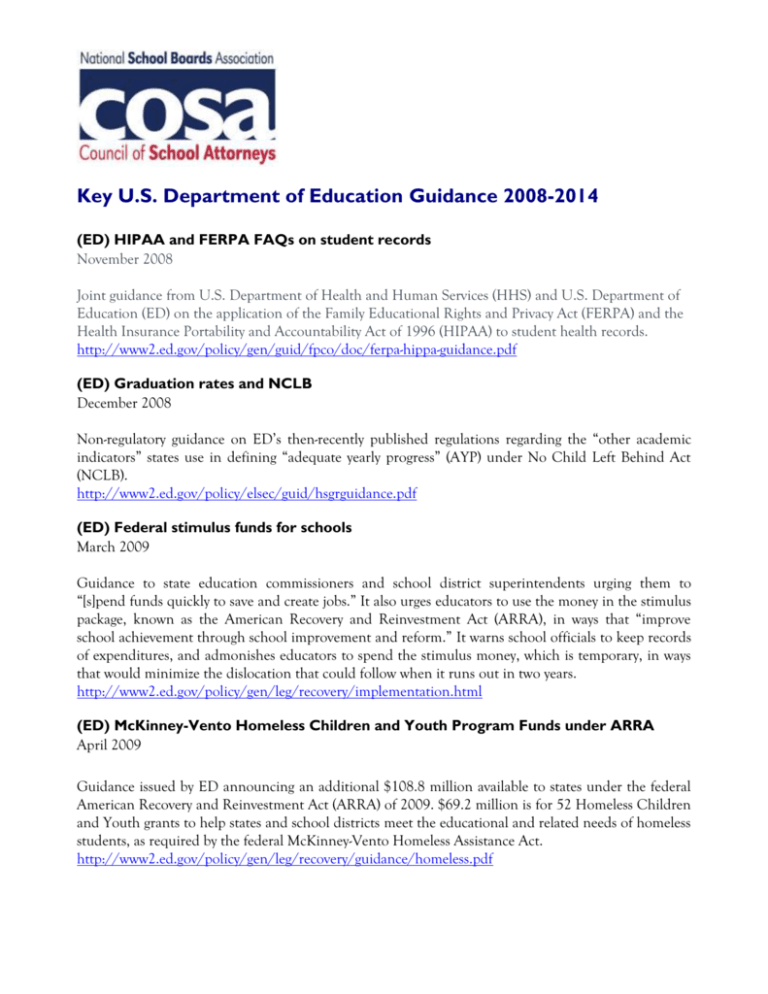
Key U.S. Department of Education Guidance 2008-2014
(ED) HIPAA and FERPA FAQs on student records
November 2008
Joint guidance from U.S. Department of Health and Human Services (HHS) and U.S. Department of
Education (ED) on the application of the Family Educational Rights and Privacy Act (FERPA) and the
Health Insurance Portability and Accountability Act of 1996 (HIPAA) to student health records.
http://www2.ed.gov/policy/gen/guid/fpco/doc/ferpa-hippa-guidance.pdf
(ED) Graduation rates and NCLB
December 2008
Non-regulatory guidance on ED’s then-recently published regulations regarding the “other academic
indicators” states use in defining “adequate yearly progress” (AYP) under No Child Left Behind Act
(NCLB).
http://www2.ed.gov/policy/elsec/guid/hsgrguidance.pdf
(ED) Federal stimulus funds for schools
March 2009
Guidance to state education commissioners and school district superintendents urging them to
“[s]pend funds quickly to save and create jobs.” It also urges educators to use the money in the stimulus
package, known as the American Recovery and Reinvestment Act (ARRA), in ways that “improve
school achievement through school improvement and reform.” It warns school officials to keep records
of expenditures, and admonishes educators to spend the stimulus money, which is temporary, in ways
that would minimize the dislocation that could follow when it runs out in two years.
http://www2.ed.gov/policy/gen/leg/recovery/implementation.html
(ED) McKinney-Vento Homeless Children and Youth Program Funds under ARRA
April 2009
Guidance issued by ED announcing an additional $108.8 million available to states under the federal
American Recovery and Reinvestment Act (ARRA) of 2009. $69.2 million is for 52 Homeless Children
and Youth grants to help states and school districts meet the educational and related needs of homeless
students, as required by the federal McKinney-Vento Homeless Assistance Act.
http://www2.ed.gov/policy/gen/leg/recovery/guidance/homeless.pdf
(ED) Individuals with Disabilities Education Act
June 2009
Guidance in the form of FAQs regarding key aspects of the Individuals with Disabilities Education Act
(IDEA):
Discipline - provides guidance on discipline policies enacted for school-age students to personnel in
state educational agencies (SEAs) and local educational agencies (LEAs), and families.
Disproportionality - provides information regarding the IDEA requirements relating to
disproportionality determinations.
Procedural Safeguards - lists questions and answers on Procedural Safeguards and Due Process
Procedures for Parents and Children with Disabilities issued in January 2007.
Technical Assistance and Enforcement - provides information on IDEA requirements relating to
monitoring, technical assistance, and enforcement.
Secondary Transition - lists questions and answers regarding transition services for special education
students.
(ED) Title I, Part A Waivers
July 2009
Comprehensive information on how to request a waiver of specific statutory and regulatory provisions
of Title I, Part A of the Elementary and Secondary Education Act of 1965 (ESEA).
http://gm6-nsba.syscomservices.com/SchoolLaw/Issues/NCLB/NCLB-Non-Regulatory-GuidanceNCLB-Waivers.pdf
(ED) Flexibility and waivers for SEAs, LEAs, postsecondary institutions, and other
grantee and program participants in responding to pandemic influenza (H1N1 Virus)
September 2009
Guidance discussing waivers from federal education requirements that may provide state or local
educational institutions with the operational flexibility necessary to efficiently close schools and
otherwise respond to the administrative challenges presented by a potential H1N1 outbreak such as:
prolonged school closures, excessive absenteeism, or other disruptions in the regular delivery of
educational services to students for a prolonged period of time.
http://www.edweek.org/media/swineguidance.pdf
Key U.S. Department of Education Guidance 2008 - 2014
August 29, 2014
Page 2 of 7
(ED) Family Educational Rights and Privacy Act (FERPA) and H1N1 Influenza
October 2009
Guidance addressing concerns that school officials may have about disclosing personally identifiable
information about students in the event of an outbreak of H1N1 influenza in their schools.
http://www2.ed.gov/policy/gen/guid/fpco/pdf/ferpa-h1n1.pdf
(ED) Stricter enforcement of Title IX in women’s athletics
April 2010
Guidance reversing a 2005 policy allowing schools to use only a survey to prove a lack of interest in
starting a new women's sport and encouraging schools to consider a non-response to the survey as
disinterest. The guidance requires schools and colleges to provide stronger evidence that they offer
equal opportunities for athletic participation under Title IX. Schools have three ways to comply with
Title IX: match the proportion of female athletes to the proportion of women on campus; show a
history of increasing sports offerings for women; or prove that the school has met the interest and
ability of women to participate in athletics. Before 2005, the third option required districts and colleges
to use multiple indicators to assess athletic interests and abilities. This guidance informs institutions
that survey results alone cannot justify an imbalance in women's sports.
http://www2.ed.gov/about/offices/list/ocr/letters/colleague-20100420.pdf
(ED) Bullying and harassment
October 2010
“Dear Colleague” letter issued by ED’s Office for Civil Rights (“OCR”) in the midst of a campaign by
the Obama administration to prevent anti-gay bullying and other harassment at school. It clarifies the
applicability of Title IX to harassment based on actual or perceived sexual orientation. The letter states
that a school district is “responsible for addressing harassment incidents about which is knows or
reasonably should have known;” and “Harassment creates a hostile environment when the conduct is
sufficiently severe, pervasive or persistent so as to interfere with or limit a student’s ability to participate in
or benefit from the services, activities, or opportunities offered by the school.” (Emphasis added.)
http://www2.ed.gov/about/offices/list/ocr/letters/colleague-201010.html
Fact sheet October 26, 2010
http://www2.ed.gov/about/offices/list/ocr/docs/dcl-factsheet-201010.html
Letter from Duncan to state officials and examples of provisions in state anti-bullying laws December
16, 2011
http://www2.ed.gov/policy/gen/guid/secletter/101215.html
NSBA December 2010 letter asking for clarification of OCR’s October 2010 DCL
http://www.nsba.org/sites/default/files/reports/NSBA%20Response%20to%20OCR%20Guidance%
20December%202010.pdf
OCR response to NSBA’s December 2010 letter seeking clarification of OCR’s October 2010 DCL
http://www.nsba.org/sites/default/files/reports/ED_Response_-_NSBA_Bullying_Letter_2011.pdf
Key U.S. Department of Education Guidance 2008 - 2014
August 29, 2014
Page 2 of 7
(ED) E-readers accessibility for students with disabilities
May 2011
FAQ stating that schools have a legal obligation under both Section 504 of the Rehabilitation Act of
1973 and Title II of the Americans with Disabilities Act to provide visually impaired students with
comparable technology that affords “substantially equivalent ease of use.” This same level of “ease of
use” must also be provided to students with disabilities other than visual impairment that makes them
unable to process printed information.
http://www2.ed.gov/about/offices/list/ocr/docs/dcl-ebook-faq-201105.html
(ED)Treatment of LGBT student groups (GSA) under Equal Access Act
June 2011
“Dear Colleague” letter emphasizing that schools must treat all student-initiated groups equally
pursuant to the Equal Access Act. The guidance’s thrust is to warn school officials against taking steps
to ban students from forming gay-straight alliances and similar support groups in their schools. It is
accompanied by the legal guidelines issued by the Education Department’s (ED) General Counsel
Charles P. Rose. Duncan’s warning follows up ED’s October 2010 letter to districts about how
bullying, in particular of students who are lesbian, gay, bisexual, and transgender, may violate students’
civil rights.
http://www2.ed.gov/policy/elsec/guid/secletter/110607.html
(ED/DOJ) Voluntary use of race
December 2011
“Dear Colleague” letter and accompanying guidance documents replacing August 2008 letters titled
“The Use of Race in Assigning Students to Elementary and Secondary Schools” and “The Use of Race
in Postsecondary Student Admissions” issued by OCR that essentially warned colleges and universities
against considering race at all. The new guidelines stress that in some cases “race can be outcome
determinative.” ED and DOJ also issued parallel guidelines to the nation’s 17,000 public school
districts, explaining what government lawyers consider to be acceptable ways that educators can seek to
reduce racial segregation. In regard to K-12 schools, the guidelines inform school districts rthat they
can craft policies on locating schools, drawing attendance boundaries and governing student transfers
to achieve a better racial mix. http://www2.ed.gov/about/offices/list/ocr/letters/colleague201111.html
(ED) Enrollment practices
May 2011
“Dear Colleague” letter, fact sheet, and question and answer document on school district enrollment
practices cautioning against practices that may discourage undocumented students or parents from
enrolling students in school.
http://www2.ed.gov/about/offices/list/ocr/letters/colleague-201101.pdf
Key U.S. Department of Education Guidance 2008 - 2014
August 29, 2014
Page 2 of 7
(ED/DOJ) College/university admission policies and K-12 student assignment plans
December 2011
Guidelines replacing a 2008 document that essentially warned colleges and universities against
considering race at all. Here, ED and DOJ issue parallel guidelines to the nation’s 17,000 public school
districts, explaining what government lawyers consider to be acceptable ways that educators can seek to
reduce racial segregation, which has been increasing nationwide. The guidelines are designed to give
educators a clear interpretation of three high court cases that, since 2003, have limited the use of race
in admissions, zoning and other school policies.
K-12 guidance: http://www2.ed.gov/about/offices/list/ocr/docs/guidance-ese-201111.html
(ED) Schools’ responsibilities under ADA and Rehabilitation Act
January 2012
“Dear Colleague” letter and Frequently Asked Questions document on the requirements of the
Americans with Disabilities Act (ADA) and Section 504 of the Rehabilitation Act (Section 504) in
elementary and secondary schools, given the changes to those laws made by the ADA Amendments
Act. The Act, effective January 1, 2009, “broadened the meaning of disability and, in most cases, shifts
the inquiry away from the question of whether a student has a disability as defined by the ADA and
Section 504, and toward school districts’ actions and obligations to ensure equal education
opportunities.”
DCL: http://www2.ed.gov/about/offices/list/ocr/letters/colleague-201109.html
FAQs: http://www2.ed.gov/about/offices/list/ocr/docs/dcl-504faq-201109.html
OCR January 2013 DCL disabled students participation in extracurricular activites \
http://www2.ed.gov/about/offices/list/ocr/letters/colleague-201301-504.pdf
NSBA May 2013 letter asking for clarification of OCR’s January 2013 DCL
http://www.nsba.org/sites/default/files/reports/Letter%20to%20Hon%20%20Seth%20Galanter%20
%28Re-DCL-1-125-13%29May%202013.pdf
OCR December 2013 response to NSBA’s May 2013 letter seeking clarification
http://www.nsba.org/sites/default/files/reports/OCR%20Dec.%2016%20%20Letter%20%20RE%20-%20NSBA%20May%202013%20Letter.pdf
(ED) Schools’ responsibilities to pregnant and parenting students under Title IX
June 2013
Pamphlet providing background on school retention problems associated with young parents and the
requirements related to these issues contained in the Department’s regulation implementing Title IX.”
http://www2.ed.gov/about/offices/list/ocr/docs/pregnancy.pdf
Key U.S. Department of Education Guidance 2008 - 2014
August 29, 2014
Page 2 of 7
(ED) Schools’ responsibilities re: bullying of disabled students
August 2013
Guidance issued by ED’s Office of Special Education and Rehabilitative Services (OSERS) on bullying
of students with disabilities. According to ED, the “guidance provides an overview of school districts’
responsibilities to ensure that students with disabilities who are subject to bullying continue to receive
free appropriate public education (FAPE) under the Individuals with Disabilities Education Act
(IDEA).”
http://www2.ed.gov/policy/speced/guid/idea/memosdcltrs/bullyingdcl-8-20-13.pdf
(ED/DOJ) Unlawful discriminatory practices in student discipline
January 2014
Guidance intended to “help public elementary and secondary schools administer student discipline in
a manner that does not discriminate on the basis of race.” While focused on race, the DCL also
reminds schools, “Federal law also prohibits discriminatory discipline based on other factors, including
disability, religion, and sex.” The DCL refers to information obtained through the OCR’s Civil Rights
Data Collection (CRDC) to set the basis for its concerns and guidance. The CRDC data demonstrates
“that students of certain racial or ethnic groups tend to be disciplined more than their peers.”
http://www2.ed.gov/about/offices/list/ocr/letters/colleague-201401-title-vi.pdf
(ED) Guidance on privacy of student data shared with third-party providers of online
services
February 2014
Guidance on legal requirements and best practices on the use, storage, and security of student data
when schools use online educational resources, issued by ED’s Privacy Technical Assistance Center
(PTAC). The guidelines are ED’s attempt to light the way through the rapidly evolving world of
educational technology and student data privacy.
http://blogs.edweek.org/edweek/DigitalEducation/Student%20Privacy%20and%20Online%20Educa
tional%20Services%20%28February%202014%29.pdf
(ED) Disabled students, ELL, admissions, and discipline in charter schools
May 2014
“Dear Colleague” letter issued by OCR for charter schools related to student admissions, students with
disabilities, English-language learners (ELL), and student discipline.
http://www2.ed.gov/about/offices/list/ocr/letters/colleague-201405-charter.pdf
Key U.S. Department of Education Guidance 2008 - 2014
August 29, 2014
Page 2 of 7
(ED) Title IX and sexual violence
May 2014
Q&A document updating Title IX guidance clarifying that the civil rights law’s protection extends to
all students, regardless of sexual orientation or gender identity. ED’s announcement of its
interpretation of Title IX’s applicability to sexual orientation and gender identity applies equally to
public elementary and secondary schools.
http://www2.ed.gov/about/offices/list/ocr/docs/qa-201404-title-ix.pdf
(ED) Use of student data
July 2014
Guidance for schools and districts on how to keep parents and students better informed about what
student data is collected and how it is used. In the guidance issued by the Department’s Privacy
Technical Assistance Center (PTAC), titled “Transparency Best Practices for Schools and Districts,”
schools and districts are urged to be proactive in communicating how they use student data.
http://ptac.ed.gov/sites/default/files/LEA%20Transparency%20Best%20Practices%20final.pdf
Key U.S. Department of Education Guidance 2008 - 2014
August 29, 2014
Page 2 of 7

